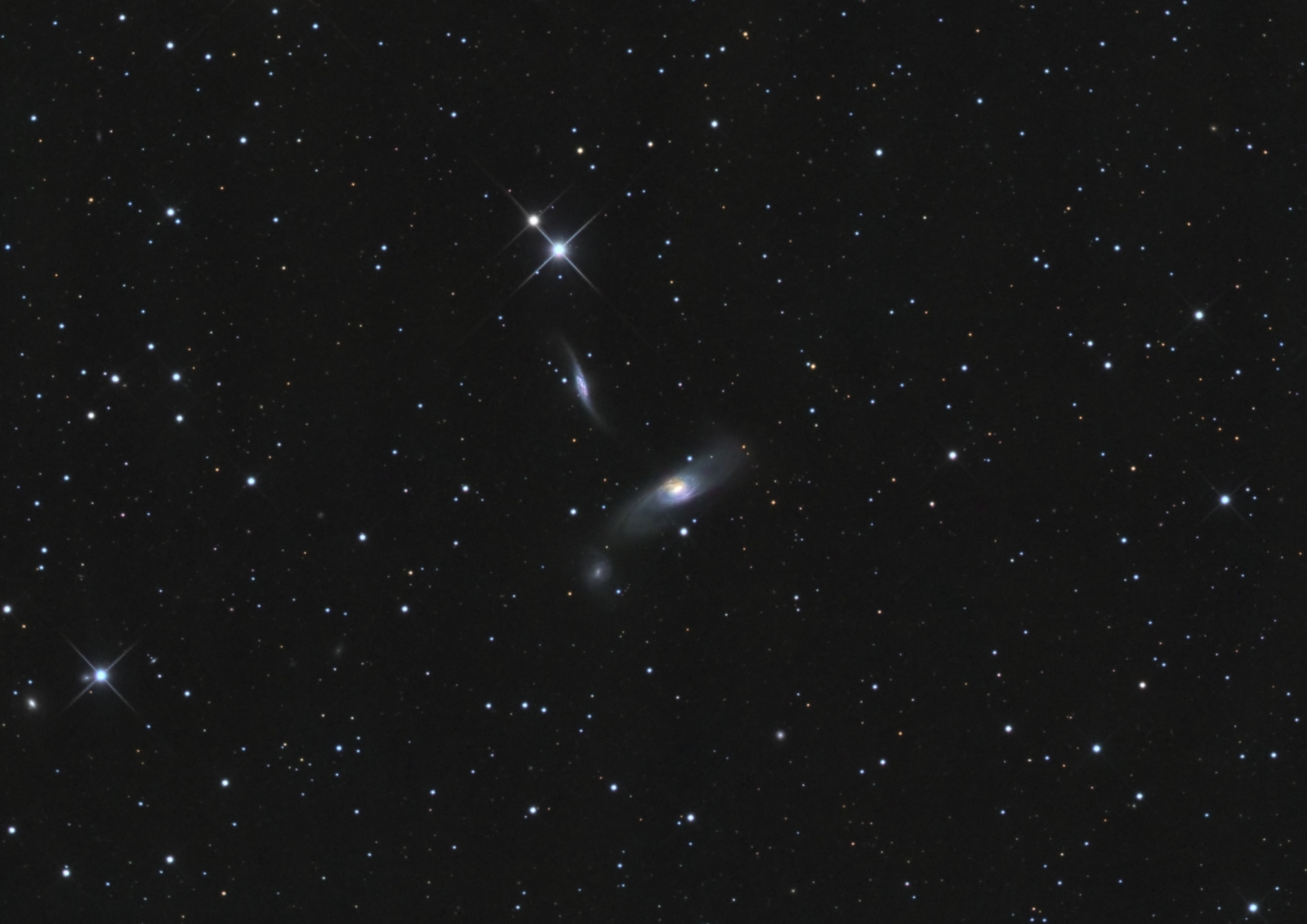Arp 286 Galaxy Group

Click image for full size version
May 15, 2016; Astronomy Magazine Online Picture of the Day, April 25, 2017
 Arp 286 is a pretty group of three gravitationally bound galaxies that lies in Virgo about 90 million light years away. The largest of the three, the barred spiral galaxy NGC5566, is the largest galaxy in Virgo, at 150,000 light years across. To its lower left is small NGC5569. The reverse-S-shaped galaxy is NGC5560, whose arms are thought to be distorted by its interaction with NGC5566. Many other galaxies dot the field. Arp refers to Halton Arp, who compiled a catalogue of peculiar galaxies.
Arp 286 is a pretty group of three gravitationally bound galaxies that lies in Virgo about 90 million light years away. The largest of the three, the barred spiral galaxy NGC5566, is the largest galaxy in Virgo, at 150,000 light years across. To its lower left is small NGC5569. The reverse-S-shaped galaxy is NGC5560, whose arms are thought to be distorted by its interaction with NGC5566. Many other galaxies dot the field. Arp refers to Halton Arp, who compiled a catalogue of peculiar galaxies.
Tekkies:
SBIG STL-11000M camera, Baader LRGB filters, 10″ f/6.8 ASA astrograph, Paramount MX. Guided with QHY5 on an 80 mm f/6 refractor. FocusMax for focusing and CCD Commander to automate the sessions. Acquistion and guiding with TheSkyX. All pre-processing and processing in PixInsight. Shot from my SkyShed in Guelph, Ontario. RGB under moonlight and luminance with no moon. Average transparency and seeing.
8x15m R, G and B and 26x15m L unbinned frames (total=12hr).
RGB
Creation and cleanup: R, G and B masters were prepared with ImageIntegration. The R, G and B masters were combined with ChannelCombination, and the resulting RGB image was cropped and processed with DBE (to applications were needed), followed by ColorCalibration using the central galaxy as the white reference.
Linear Noise Reduction: MultiscaleLinearTransform was used to reduce noise in the background areas of the RGB image. Layer settings for threshold and strength: Layer 1: 3.0, 0.5 Layer 2: 2.0, 0.39 Layer 3: 1.0, 0.25 Layer 4: 0.5, 0.1. A mask was used to protect high signal areas (Amplification 120; Smoothness 1.0).
Stretching: HistogramTransformation was applied to make a pleasing yet bright RGB image.
Synthetic Luminance
Creation and cleanup: An L master was created with ImageIntegration. The SynthL was made by combining the L, R, G and B masters using ImageIntegration (average, additive with scaling, noise evaluation, iterative K-sigma/biweight midvariance, no pixel rejection) to create the SynthL channel. The image was cropped to match the RGB and DBE was applied.
Deconvolution: A copy of SynthL was stretched to use as a deconvolution mask. A star mask was made from unstretched SynthL to use as a local deringing support. Deconvolution was applied (80 iterations, regularized Richardson-Lucy, external PSF made using DynamicPSF tool with about 25 stars; local deringing at 70% and global dark deringing at 0.02).
Linear Noise Reduction: MultiscaleLinearTransform was applied to reduce the noise. Layer settings for threshold and strength: Layer 1: 3.0, 0.6 Layer 2: 2.0, 0.5 Layer 3: 1.0, 0.4 Layer 4: 0.5, 0.15
Stretching: HistogramTransformation was applied to make an image with similar brightness to the RGB image.
Nonlinear Noise Reduction: TGVDenoise was applied using a mask to protect stars and galaxies, and the image was re-stretched with HistogramTransformation.
Combining SynthL with RGB:
The luminance channel of the RGB image was extracted, processed and then added back into the RGB image as follows:
1. RGBWorkingSpace was applied to the RGB image with all channels equal to 0.33
2. Extract luminance from the RGB image.
3. Apply LinearFit to the extracted luminance using SynthL as the reference.
4. Use ChannelCombination in Lab mode to replace the RGB’s luminance with the fitted luminance from step 3.
5. LRGBCombine was then used to make a SynthLRGB image.
Final Processing
UnsharpMask was applied to the galaxies using a mask. Contrast, brightness and saturation were adjusted in several iterations with the Curves tool, with separate adjustments made for background, stars and galaxies using different masks.
Image scale is about 1.1 arcsec per pixel for this camera / telescope combination.






Leave A Comment